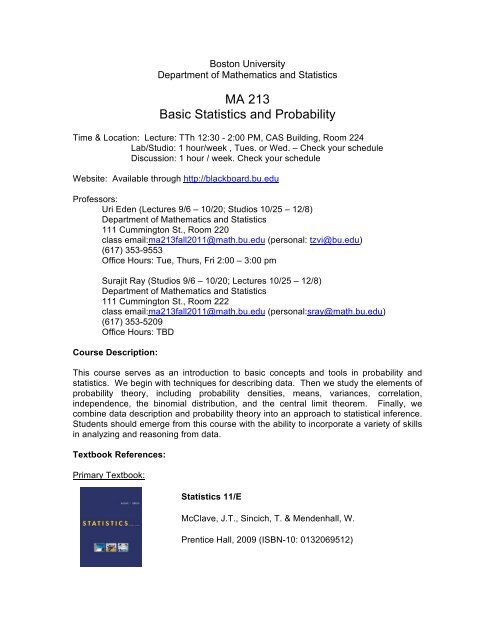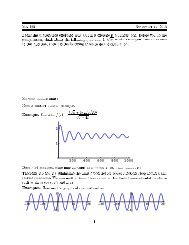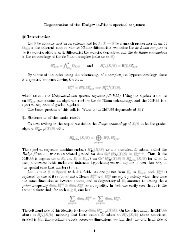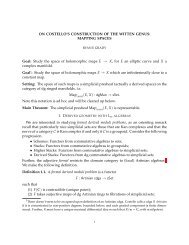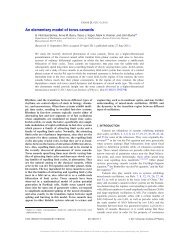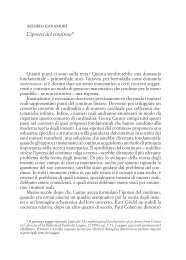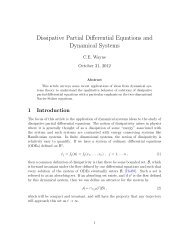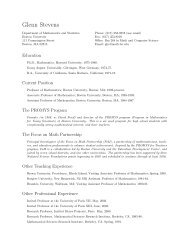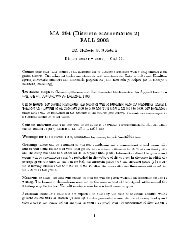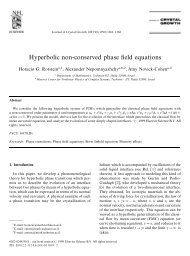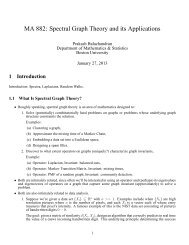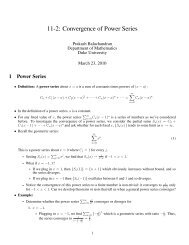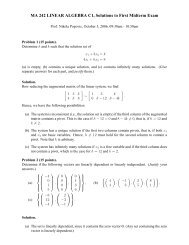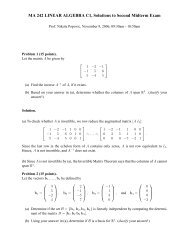Download - Mathematics & Statistics - Boston University
Download - Mathematics & Statistics - Boston University
Download - Mathematics & Statistics - Boston University
You also want an ePaper? Increase the reach of your titles
YUMPU automatically turns print PDFs into web optimized ePapers that Google loves.
<strong>Boston</strong> <strong>University</strong><br />
Department of <strong>Mathematics</strong> and <strong>Statistics</strong><br />
MA 213<br />
Basic <strong>Statistics</strong> and Probability<br />
Time & Location: Lecture: TTh 12:30 - 2:00 PM, CAS Building, Room 224<br />
Lab/Studio: 1 hour/week , Tues. or Wed. – Check your schedule<br />
Discussion: 1 hour / week. Check your schedule<br />
Website: Available through http://blackboard.bu.edu<br />
Professors:<br />
Uri Eden (Lectures 9/6 – 10/20; Studios 10/25 – 12/8)<br />
Department of <strong>Mathematics</strong> and <strong>Statistics</strong><br />
111 Cummington St., Room 220<br />
class email:ma213fall2011@math.bu.edu (personal: tzvi@bu.edu)<br />
(617) 353-9553<br />
Office Hours: Tue, Thurs, Fri 2:00 – 3:00 pm<br />
Surajit Ray (Studios 9/6 – 10/20; Lectures 10/25 – 12/8)<br />
Department of <strong>Mathematics</strong> and <strong>Statistics</strong><br />
111 Cummington St., Room 222<br />
class email:ma213fall2011@math.bu.edu (personal:sray@math.bu.edu)<br />
(617) 353-5209<br />
Office Hours: TBD<br />
Course Description:<br />
This course serves as an introduction to basic concepts and tools in probability and<br />
statistics. We begin with techniques for describing data. Then we study the elements of<br />
probability theory, including probability densities, means, variances, correlation,<br />
independence, the binomial distribution, and the central limit theorem. Finally, we<br />
combine data description and probability theory into an approach to statistical inference.<br />
Students should emerge from this course with the ability to incorporate a variety of skills<br />
in analyzing and reasoning from data.<br />
Textbook References:<br />
Primary Textbook:<br />
<strong>Statistics</strong> 11/E<br />
McClave, J.T., Sincich, T. & Mendenhall, W.<br />
Prentice Hall, 2009 (ISBN-10: 0132069512)
Other References:<br />
Introductory Probability:<br />
Weiss, N. A Course in Probability. Pearson Education, Inc., 2006<br />
Other <strong>Statistics</strong> Texts:<br />
D’Agostino, R.B., Sullivan, L.M. & Beiser, A.S. Introductory Applied Biostatistics.<br />
Brooks Cole, 2005.<br />
Clickers:<br />
Wasserman L. All of <strong>Statistics</strong>: A Concise Course in Statistical Inference.<br />
Springer, 2003<br />
We will be using an audience response system (i.e. clickers) in class<br />
to poll for information, check comprehension, and collect data for<br />
analysis. You are required to bring your clicker to every lecture and<br />
lab/studio session. Clickers can be purchased from the BU bookstore<br />
or online.<br />
Laboratory/Studio Sections:<br />
The laboratory/studio sections provide you the opportunity to work in groups to solve<br />
problems in probability theory and data analysis. You will conduct experiments and use<br />
statistical software to solve these problems. You will be assigned to groups during the<br />
first studio section. This will be your group for the course project as well as the studio<br />
sections. Please coordinate within your group to ensure that at least one member brings<br />
a laptop computer to each section (There is no harm in more than one person bringing<br />
laptops). The statistical software for the class is JMP, which can be downloaded free<br />
from the BU software page: https://www.bu.edu/software/stats/jmp/.<br />
Discussion Sections:<br />
The discussion sections provide you the opportunity to ask questions about any of the<br />
course material, past or current assignments, or any subjects beyond the material<br />
covered in lecture. We will also go through examples drawn from lectures and questions<br />
on the discussion board on the course website. Please complete all reading<br />
assignments before your section, and prepare questions in advance.<br />
Assignments:<br />
Problem sets:<br />
Take-home problem sets will be assigned regularly and due one week from when they<br />
are assigned. These assignments will consist of problems taken from the course<br />
textbook and additional questions taken from other sources. Please feel free to<br />
collaborate on these, but each student should hand in their own problem set, which<br />
reflects your own understanding of the material. The problem sets will determine 25% of<br />
the final grade.
Laboratory Reports:<br />
For each lab/studio section, there will be a prelab, in-lab, and postlab document with<br />
questions to answer. Each group should turn in one report, due one week after the lab<br />
section. The lab reports will determine 5% of the final grade.<br />
Data Collection and Analysis Project:<br />
You will work in groups to complete a semester long project, in which you will identify<br />
some interesting questions to address, collect data, and perform a statistical analysis<br />
using the methods we will learn in class. You will hand in a number of project milestones<br />
throughout the semester, submit a final project report, and present your findings to the<br />
class. Please see the Project description handout for more details about the project. The<br />
project will determine 20% of your final grade.<br />
Midterm Exam:<br />
There will be one in-class midterm exam, given on October 27 th . If you cannot make it to<br />
class for an exam, a make-up exam can be arranged, which may be a written or oral<br />
exam, by contacting one of the professors in advance. The midterm exam will determine<br />
20% of the final grade.<br />
Final Exam:<br />
The final exam for this course will be on Wednesday, December 21 st from 9:00-11:00<br />
AM. The final exam will not be offered at any other dates and times. The final exam will<br />
determine 30% of the final grade.<br />
Extra Credit Opportunities:<br />
There are a number of ways to earn extra credit for the course. In each class, there will<br />
be clicker questions to test your comprehension of the material; the more questions you<br />
get right, the more extra credit you earn. You will also earn a bonus for answering at<br />
least 90% of all the clicker questions in the lecture and lab/studio sections. We will also<br />
award extra credit points for outstanding participation in the discussion sections and in<br />
the forums on the course website.


